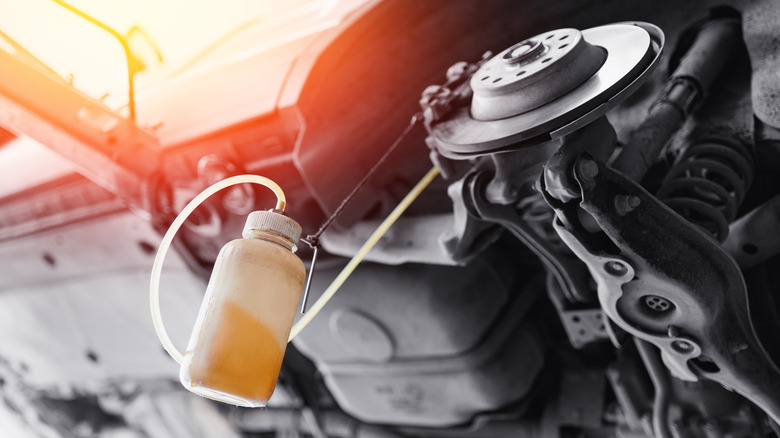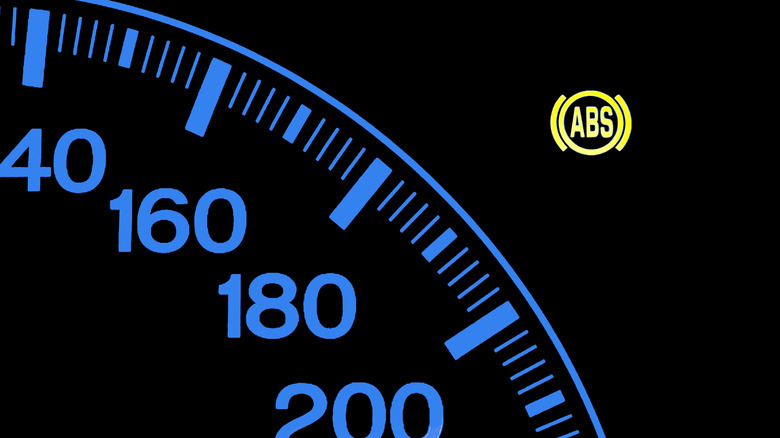How Often Does Your Car's Brake Fluid Really Need To Be Replaced?
To most drivers, an oil change, a fresh oil filter, maybe some new spark plugs, and a quick tire check is enough car maintenance. Fair enough — but when did your brake fluid last cross your mind? You probably forgot it even exists. "But I just got my brakes checked." Sure, but your mechanic probably just threw in some new rotors for those squeaks or a new set of pads for sharper brakes. Meanwhile, your brake fluid could be quietly overdue for a flush.
In fact, a 2021 study published in Periodica Polytechnica Transportation Engineering examined the condition of brake fluid in passenger cars and discovered that, even within the fluid's expected service life, degradation is prevalent. So, if you've been driving your car some time now, and not even once have you had your brake fluid changed, it's probably time.
There is no one-size-fits-all interval standard on how often to change brake fluid, as that may vary with the car make and model, driving habits, and the brake fluid's quality. However, as a general rule of thumb, flush your car's brake fluid at least every two years. This applies to most car models, but assuming you still have your car's maintenance schedule papers, you'll find the manufacturer's recommended interval on there, both in time and mileage.
Why change the brake fluid in the first place?
Just like engine oil, brake fluid breaks down over time, consequently losing its effectiveness. In theory, it shouldn't — after all, it is part of a tightly sealed system and the fluid itself is noncompressible. However, reality doesn't quite pan out that way, as moisture and heat find their way in eventually.
Over time, the fluid absorbs water, picks up debris, and even air finds its way inside, impairing your braking system's effectiveness. That's how you end up with a spongy brake pedal, or worse, brakes that don't stop as quickly as they should, which is dangerous, to say the least.
How does this happen? Well, brake fluid is hygroscopic. If you remember science lessons at school, this means it naturally attracts and absorbs moisture, which gradually contaminates the system. Here's where things start getting mushy: Brake fluid typically has a very high boiling point, at around 440 degrees Fahrenheit, compared to 212 degrees Fahrenheit for moisture, which is basically water.
If a lot of water finds its way into your brake lines, that's a recipe for disaster. Not only can it rust out your brake lines, but it could also lower the brake fluid's boiling point. That means during intense braking, the fluid can quickly steam up, leaving you with vapor pockets instead of brute braking power — not exactly the kind of surprise you'd want when it's you behind the wheel.
How to check if your brake fluid is due
The first red flag is often a soft, spongy brake pedal –- it starts feeling soft, or it sinks too far before the brakes start to respond, taking forever to come to a complete stop. When this happens, it means there's air or moisture in the lines. Some car models may also turn up the ABS warning light to let you know something's wrong with your anti-lock braking system, often a sign of low brake fluid.
To check your brake fluid, simply pop the hood to locate the brake fluid reservoir. It's typically on the driver's side, close to engine bay rear side. You'll see a translucent reservoir with some liquid in it. Check the fluid level — the reservoir often has two lines, MIN and MAX, so ideally, your brake fluid level should be between the two lines.
If lower than MIN, you could have a leak somewhere along the brake lines. Also, take note of the color. Healthy brake fluid should be clear, if not faintly yellow. If sludgy, dark, or cloudy is all you see when you look at yours, a complete drain is necessary. If the fluid is clean, but just a bit low, you can top it up yourself with the correct type of brake fluid for your vehicle. If it's dirty, however, it's best to call the pros for a proper flush.


